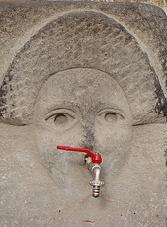You are currently browsing the daily archive for June 28, 2006.
$291,895,082,161
Instead, we could have provided 14,150,436 students four-year scholarships at public universities.
Instead, we could have insured 174,787,638 children for one year.
To watch the numbers rise, go to the National Priorities Project
Bill Moyers’ new series, Faith and Reason, is in some ways more compelling than his topical series, NOW, which has been truncated to a half-hour, sans Bill Moyers, due to right wing accusations of liberal bias. Moyers is more in his element here, conducting longer, in-depth interviews with writers on a subject that obviously fascinates him, harkening back to his now classic interviews with mythologist Joseph Campbell.
These interviews are significant and compelling because they further problematize what is already problematic—the tension between organized religion, still part of many people’s lives, and the secular humanist values that define much of the western world’s social infrastructure, particularly in a democracy. Sam Harris explored these issues, in a decidedly biased way, in the bestselling book The End of Faith. In a world in which fundamentalist religion wreaks so much havoc, it seems that people are, unconsciously at least, seeking new paradigms for their conception of the divine. Did the fervor over the Da Vinci Code spring from people’s need for a damn good mystery or from the need for a more fully human Christ, a family man that one can relate to, rather than the rabbinical and cryptic Jesus of Mathew or the more abstract, inaccessible, and iconic Jesus of John? Or did it spring from a desire to debunk and transcend beliefs that many consider metaphoric and many others consider poppycock?
The latest interview, with Salman Rushdie, was truly provocative and thought provoking, and if not seen, can be appreciated through the transcript, available on Moyers’ site. Rushdie speaks about Islam; fundamentalism; the fatwa that caused him to go underground for nearly ten years; the role of the artist, particularly in relation to religion and spirituality; and the nature of morality.
Rushdie had the following to say in response to the Danish cartoon controversy:
I think there’s two subjects on the Danish cartoon. There’s the cartoons themselves. Would you have published them, should you have published them? And I think these are arguments that newspapers have every day. You know, what’s an appropriate editorial stance on a given issue? So, I think we could have that argument in a kind of straight forward civil discourse. And we can have different points of view about it. I think the second thing that happened was the enormously violent and intimidatory response. And then the question I think changes. The question becomes how do you respond to intimidation? And I’m afraid that many of the people who refused to stock the cartoons, who refused to reprint them, claiming that they were being respectful were actually not being respectful, they were being scared, you know. And I think the problem is with intimidation is that if you do surrender to it you make sure that there will be more intimidation in the future.
Rushdie recently appeared at the PEN World Voices festival of writers where he read from his work. PEN International continues to do the important work of promoting free expression and advancing literature and literary fellowship. Its Prison Writing Program has been particularly successful.
He’s at it again, folks, that pill-popping pharmaceutical-abusing pillar of the right. This time, the staunch abortion opponent procured some Viagra for his trip to the Dominican Republic, known for its sex trade (what happens in the Dominican Republic stays in the Dominican Republic), and one only hopes that he used a condom.
This from the Department of State’s own report on Human Rights Practices:
Accion SIDA, an HIV/AIDS NGO, estimated that children constituted 10 to 15 percent of the total number of persons engaged in the country’s sex industry. Some elements within the tourist industry facilitated the sexual exploitation of children; particular problem areas were Boca Chica and Puerto Plata. Tours were marketed by foreigners overseas with the understanding that boys and girls could be found as sex partners. In July the National Prosecutor’s Office and the Association of Hotels signed an agreement to combat the exploitation of children in the tourist industry. Journalists reported that a large number of prostitutes in brothels around the National District appeared to be between 16 and 18 years of age. Newspaper reports indicated that as many as 30,000 children and adolescents may be involved in the sex industry. There were several church-run shelters that provided refuge to children who escaped prostitution. Prostitution was the principal means of exploitation of underage girls in the informal economy.
The Interinstitutional Committee for the Protection of Migrant Women, composed of seven governmental institutions, one professional association, two nongovernmental organizations and a religious order, became the lead organization dealing with this problem through its regular monthly meetings and its cosponsorship of an August seminar on the role of the State and civil society with respect to fighting trafficking. It also assumed a coordination function since it was comprised of the key agencies and organizations interested in and responsible for combating trafficking.
The Secretariat of Labor also became much more involved with trafficked minors through its program to fight the worst forms of child labor. The ILO began a pilot program in Boca Chica to identify and work with children involved in the sex trade and to coordinate with the Secretariats of Health and Education to provide psychological support and medical assistance, and to return the children to the classroom.
COIN counseled women planning to accept job offers in Europe and the eastern Caribbean about immigration, health, and other issues including the dangers of trafficking, forced prostitution, and domestic servitude. The program also provided services to returning women. COIN administered the Center for Health and Migration Information for Migrant Women that carried out community education campaigns in high risk areas on various issues, including citizenship, legal work requirements, dangers of trafficking, forced prostitution, and domestic servitude.
Says Rush, “The people at Customs were as nice as they could be; they just didn’t believe me when I told them that I got those pills from the Clinton Library gift shop. They told me at the Clinton Library gift shop that they were just little blue M&Ms.”
And, after all that, he still had time for dinner at the Supreme Court and lunch at the White House. Check out the photos that can be found on Limbaugh’s website, particularly the one that shows a tete a tete with Supreme Court Justice Thomas. As the caption says, Wouldn’t you love to hear what they’re saying?































Recent Comments